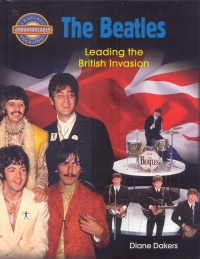| ________________
CM . . .
. Volume XX Number 7. . . .October 18, 2013
excerpt:
Diane Dakers tells the story of how, on October 31, 1963, air and ground traffic at London’s Heathrow Airport was delayed because mobs of fans wanted to see England’s newest pop sensation, a band called the Beatles. Ironically, one person stuck in an airplane circling the airport was Ed Sullivan, and when he heard about the band, Sullivan knew that he had to get them on his highly rated nationally televised show. The Beatles already had a large following of fans in North America, but full-fledged “Beatlemania” would arrive in North America when, in February 1964, the band played on the Ed Sullivan Show. Students expressing an interest in rock or social history will enjoy Diane Dakers’s well-thought-out introductory biography of the Beatles which opens the door to further exploration of popular culture. The Beatles were cultural pacesetters, and it is hard to imagine what the 1960s would have been without them. Their influence on popular culture extended well beyond their music to fashion, philosophy, eastern spiritualism and the anti-war movement. Dakers quotes Beatle biographer Chris Ingham who wrote that ‘the Beatles represent one of the few times in music history when the most popular music was also the best.” She tells the remarkable success story of how four young men became the most successful band in history and, after the band broke up, each individually became a star in his own right. John Lennon, Paul Mc Cartney, Ringo Starr and George Harrison wrote some of the most iconic songs in modern rock history. In 1957, John Lennon and Paul McCartney, two young teenagers from Liverpool, struck up a friendship based on their shared of love of music, and they started up a band. Soon George Harrison joined the two. Stu Sutcliffe and drummer Pete Best also joined the band for a short time, but Richard Starkey, known as Ringo Starr, soon replaced Best. At times, the band, in its early iterations, was called the Quarry Men, John and the Moon Dogs, Beatals, Silver Beetles and Beetles. But in August 1962, Lennon, McCartney, Harrison and Starr played their first show together. “The Fab Four,” writes Dakers, “had come together at last”, and they lasted until they broke up on April 10, 1970. The world of popular music changed forever as “Beatlemania” struck Britain within months, and the “British Invasion” of North America was soon to follow. Dakers explores how bands like the Rolling Stones, The Dave Clark Five, The Animals, The Kinks, Peter and Gordon, Gerry and the Pacemakers, Herman’s Hermits and many others crossed the Atlantic to conquer the world of pop music which, up until then, had been dominated by the American music scene. In the early 1960s, the phenomenal Beatles not only made chart-topping music, they made movies, were in cartoon shows and had their own television show. They were the first band to do music videos, and they popularized massive stadium shows. Every show they did was a madhouse of screaming fans. John Lennon hated concerts because no one could hear the music, and so the band only pretended to play their instruments. The final tour date was in 1966. After that, the band members were able to refine their musical talents and skills with longer studio sessions. The eventual outcome was 1967’s innovative album Sgt. Pepper’s Lonely Hearts Club Band, which Rolling Stone called “the most important” record of all time. The band continued together until 1970, but personal and artistic differences led to their breakup. However, as Dakers writes, their music still sells today, and new generations of fans proliferate as they listen to the creativity that was, and is, “The Beatles”. Recommended. Ian Stewart teaches at Cecil Rhodes School in Winnipeg, MB. He saw the Beatles on Ed Sullivan when he was 11-years-old in grade five.
To comment
on this title or this review, send mail to cm@umanitoba.ca.
Copyright © the Manitoba Library Association. Reproduction for personal
use is permitted only if this copyright notice is maintained. Any
other reproduction is prohibited without permission.
NEXT REVIEW |
TABLE OF CONTENTS FOR THIS ISSUE
- October 18, 2013.
AUTHORS |
TITLES |
MEDIA REVIEWS |
PROFILES |
BACK ISSUES |
SEARCH |
CMARCHIVE |
HOME |
